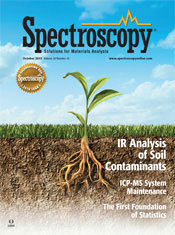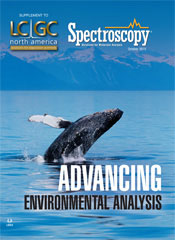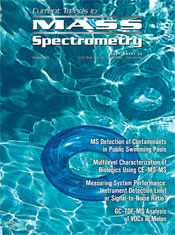In our October issue:
COLUMNS
Atomic Perspectives
Approaches to Maximize Performance and Reduce the Frequency of Routine
Maintenance in ICP-MS
Ryan Brennan, Jerry Dulude, and Robert Thomas
The importance of routine maintenance in ICP-MS cannot be overemphasized. By following the guidelines provided here, you can reduce the frequency of routine maintenance and ensure optimal instrument performance.
Read more >>
|
 |
Chemometrics in Spectroscopy
Statistics, Part I: First Foundation
Howard Mark and Jerome Workman Jr.
Modern statistics rests on three foundational principles. Here, we explain the first of these. But instead of getting involved in the nitty gritty of the equations, we approach this topic from the top down, concentrating on the core principles that apply to all major aspects of the use and application of statistical thought.
Read more >> |
| |
 |
| |
ADVERTISEMENT
New ED-XRF White Paper
Mitigating Matrix Effects with Advanced Spectra Handling Functionality
A key advantage of high accuracy ED-XRF analysis is its ability to measure samples directly, with minimal preparation enabling rapid screening. For accuracy, this requires eliminating errors called matrix effects. But for consistently high-accuracy results, especially when sample contents are unknown, additional spectra handling functionality is required. This paper explains why this additional functionality is critical to ensure consistently high-accuracy results.
 Learn more Learn more |
PEER-REVIEWED ARTICLE
VT-DRIFTS Investigations of Interactions Between Benzoic Acid and Montmorillonite Clay
Dalia K. Maraoulaite, Tara M. Nickels, Audrey L. Ingram, and Robert L. White
This variable-temperature diffuse reflection infrared Fourier transform spectroscopy (VTDRIFTS) sample perturbation method is capable of providing detailed functional group–specific information regarding temperature-dependent sample composition changes. The technique should be useful for elucidating soil transport mechanisms for selected contaminants.
Read more >>
|
ADVERTISEMENT
New Application Brief
At-Line Micronutrient Analysis Using ED-XRF Spectroscopy
The ability to conduct elemental analyses of materials at the production line is improving product quality and consistency while maximizing throughput. This is especially true in micronutrient analysis where traditional lab-based QC methods add costs and delays to processes already operating with thin margins. This paper explains how a new generation of portable lab-quality spectrometers designed to operate in a production environment is changing work processes.
 Learn more Learn more |
 |
|
 |
Download the
issues: |
 |
 |
 |
 |
 |
 |
 |
 |
| |
 |
| LIVE WEBCASTS |
CO2 Isotope Ratio Analysis on the road through Canada for environmental analysis
Tuesday, October 13, 2015 at 8 am PDT/ 11 am EDT/ 4 pm BST/ 5 pm CEST
Register Here >> |
Dealing with High-Matrix Environmental Samples: Part 2: Improve Your ICP Instrumentation Uptime—Essential Hints and Tips
Tuesday, October 20, 2015 at 8 am PDT/11 am EDT/4 pm BST/5 pm CEST
Register Here >> |
|
If you would like to submit an article to Spectroscopy, contact Laura Bush, Editorial Director - lbush@advanstar.com
Spectroscopy is free to qualified subscribers. To subscribe, click here.
Click here to contact the Spectroscopy sales team. |




